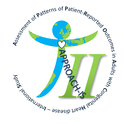Rationale
In recent decades, the life expectancy of patients with congenital heart disease (CHD) increased considerably, resulting in about 90% of children with CHD now surviving into adulthood. Furthermore, experts estimate that 1 out of 10 adults with CHD will be aged 60 years or older by the year 2030. Hence, the focus of patient management has shifted from safeguarding longevity towards improving patients’ quality of life. Due to these clinical and epidemiological changes, two important challenges emerge for our current healthcare systems.
First, as patients have a better prospect of long-term survival, a comprehensive understanding of outcomes and expectations, from the patients’ perspective, is required to advance care provision. Novel insights into international differences in patient-reported outcome measures (PROMs) among adults with CHD were obtained as part of the original APPROACH-IS study. This initial research project provided a comprehensive overview, identified geographical variation and explored the predictive value of both patient-related and country-specific characteristics for PROMs from an international perspective. However, important gaps in our knowledge base still remain. Although a broad list of PROMs was included in the original APPROACH-IS study, several PROMs were not included and no data on patient-reported experience measures (PREMs) were collected. Moreover, the initial APPROACH-IS study included 13 high-income and only two middle-income countries. An understanding of PROMs in patients living in low- and middle-income countries is currently lacking. Furthermore, only part of the variation in PROMs could be explained by geographical differences in previous studies. Therefore, we propose a second APPROACH-IS study in which we will extent the list of PROMs and PREMS, consider other explanatory variables, and aim to include data representing patients living in low-, middle- and high-income countries.
Second, as adults with CHD are ageing, many will encounter disability, morbidity, and a state of frailty, increasing patients’ susceptibility for adverse outcomes and preterm mortality. To maintain longevity and quality of life in these patients, an understanding the variables associated with prognosis, comorbidity, and mortality will enable us to map their specific healthcare needs. Frailty phenotype refers to a distinct clinical syndrome classifying patients as being either: non-frail, pre-frail or frail, based on the assessment of five respective phenotype criteria as described by Fried and colleagues. Growing evidence suggests that independent of chronological age and comorbidity, frailty phenotyping can guide risk prediction in chronically ill patients. Unfortunately, our current knowledge about epidemiological characteristics, frailty phenotype and healthcare needs of ageing adults with CHD is very limited. Hence, the APPROACH-IS II study would deliver the first set of empirical data describing the clinical and epidemiological characteristics of the emerging population of older adults with CHD.
First, as patients have a better prospect of long-term survival, a comprehensive understanding of outcomes and expectations, from the patients’ perspective, is required to advance care provision. Novel insights into international differences in patient-reported outcome measures (PROMs) among adults with CHD were obtained as part of the original APPROACH-IS study. This initial research project provided a comprehensive overview, identified geographical variation and explored the predictive value of both patient-related and country-specific characteristics for PROMs from an international perspective. However, important gaps in our knowledge base still remain. Although a broad list of PROMs was included in the original APPROACH-IS study, several PROMs were not included and no data on patient-reported experience measures (PREMs) were collected. Moreover, the initial APPROACH-IS study included 13 high-income and only two middle-income countries. An understanding of PROMs in patients living in low- and middle-income countries is currently lacking. Furthermore, only part of the variation in PROMs could be explained by geographical differences in previous studies. Therefore, we propose a second APPROACH-IS study in which we will extent the list of PROMs and PREMS, consider other explanatory variables, and aim to include data representing patients living in low-, middle- and high-income countries.
Second, as adults with CHD are ageing, many will encounter disability, morbidity, and a state of frailty, increasing patients’ susceptibility for adverse outcomes and preterm mortality. To maintain longevity and quality of life in these patients, an understanding the variables associated with prognosis, comorbidity, and mortality will enable us to map their specific healthcare needs. Frailty phenotype refers to a distinct clinical syndrome classifying patients as being either: non-frail, pre-frail or frail, based on the assessment of five respective phenotype criteria as described by Fried and colleagues. Growing evidence suggests that independent of chronological age and comorbidity, frailty phenotyping can guide risk prediction in chronically ill patients. Unfortunately, our current knowledge about epidemiological characteristics, frailty phenotype and healthcare needs of ageing adults with CHD is very limited. Hence, the APPROACH-IS II study would deliver the first set of empirical data describing the clinical and epidemiological characteristics of the emerging population of older adults with CHD.
